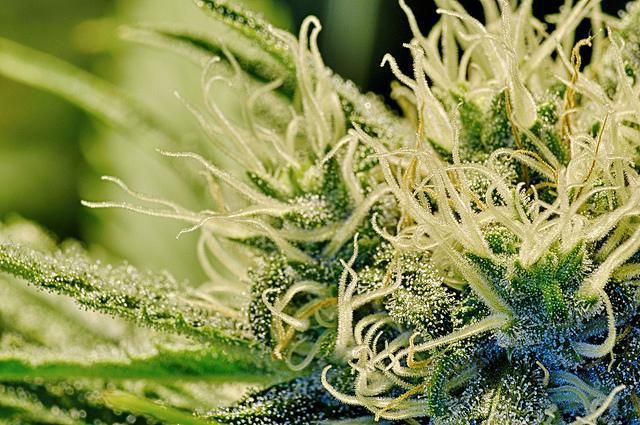- Digestive disorders are especially irritating, reducing many people's quality of life.
- Cannabis may be beneficial in these cases, relieving unpleasant symptoms such as nausea, stomachaches and loss of appetite.
- Its chemical ingredients fuse with receptors of the body's endocannabinoid system, responsible for regulating sensations such as appetite and pain, making us feel hungrier and suppressing vomiting.

American Dr Lester Grinspoon has studied the positive effects of cannabis to treat various health problems in depth. However, in the late 60s his knowledge was more limited, and there were still serious concerns and social biases against the use of the plant to alleviate the symptoms of serious illnesses. In 1967, the same year Grinspoon began researching the benefits of cannabis in the field of health, his son was diagnosed with childhood leukaemia, when he was 10 years old.
The boy soon began to receive chemotherapy for the cancer attacking his body, with negative consequences on his health. He suffered nausea and a loss of appetite that prevented him from leading a normal life. Despite having begun to research the issue, Grinspoon was not yet aware of cannabis' potential to ease discomfort caused by such aggressive treatments, but a fellow researcher told him about the case of another boy in which cannabis had helped him cope. The doctor's wife was, however, the person who decided to give her son cannabis, which he took after a chemotherapy session in 1972. After taking it he stopped vomiting and regained his appetite, explains Grinspoon.
The response by the son of this expert, author of the book Marijuana Reconsidered and Marihuana: The Forbidden Medicine, is not an isolated one. In recent decades cannabis has been shown to be effective in alleviating and even eliminating symptoms affecting the digestive system; not only nausea and loss of appetite, but also inflammation and pain. The key to understanding the effect that the plant has on this part of the body is its strong connection to the brain, and the body's nervous and endocannabinoid systems.
One of cannabis's main chemical ingredients, tetrahydrocannabinol (better known as THC) acts by binding to a group of receptors in the brain that are part of the endocannabinoid system, responsible for controlling the emotions, memory, sensitivity to pain, and appetite, among other processes. The brain naturally produces compounds called endocannabinoids, which anchor to these same receptors. THC mimics these molecules, producing the same results and even bolstering them.

Research and science open up new horizons
Different studies have demonstrated that cannabis's chemical components impact different parts of the brain, with various consequences. THC is capable of linking with the receptors of an area known as the nucleus accumbens, consisting of a group of neurons responsible for producing dopamine and, therefore, the body's sensations of pleasure and reward. Furthermore, this compound interacts with the same type of molecules in the hypothalamus, this time causing the release of the hormone ghrelin, which stimulates the appetite.
THC has the capacity to sharpen the senses of smell and taste, thus enhancing the desire to eat and the satisfaction we feel when doing so.
But there is another feature of this multifaceted molecule that is even more surprising: as revealed by a study published in the scientific journal Nature Neuroscience, THC has the capacity to sharpen the senses of smell and taste, thus enhancing the desire to eat and the satisfaction we feel when doing so. The compound and, therefore, cannabis uses different strategies to manipulate the mechanisms that the brain uses to regulate the senses, convincing the body that it is hungry.
In 1999, the Washington Institute of Medicine, a non-profit organisation founded as part of the US National Academies of Sciences, published a detailed analysis of medical cannabis, indicating many of these properties of the plant. The work took into account the results of some 15 previous studies and concluded that their results proved the therapeutic value of cannabis in relieving pain, controlling nausea and vomiting, and stimulating appetite.
Another more recent study focused on the latter property of cannabis. Its authors found a link between anorexia and bulimia nervosa and an alteration in the brain that causes the loss of endocannabinoids produced by the body. Deregulation of the endocannabinoid system causes, among other things, distortions in sensations of hunger. Hence, the compounds of cannabis, which act on the same system, can help people suffering from these diseases.
Cannabis may also provide an effective alternative for the debilitating inflammatory bowel disease known as Crohn's disease, which affects the lining of the digestive tract and is generally resistant to treatment with conventional drugs. Even with treatment, Crohn's usually advances, requiring surgery in 70% of patients. The endocannabinoid system plays a key role in inflammatory diseases of the digestive tract, as the intestine contains very high levels of cannabinoid receptors. THC and CBD activate these receptors and help to reduce chronic inflammation.

Nausea is also in the brain
But the role of cannabis's ingredients is not limited to stimulating appetite. Although it may seem surprising, nausea has a lot to do with the brain and, again, the endocannabinoid and nervous systems. This uncomfortable feeling in the stomach and throat, often accompanied by vomiting, is caused by an imbalance in one's gastric movements. The alteration may be caused by poor digestion, or the presence of some type of pathogen (bacteria or virus), or be the result of chemotherapy or radiotherapy.
THC can alleviate this unpleasant symptom, also due to its role in the body's endocannabinoid system. Binding to the receptors in the brain, it triggers chain reactions that calm spasms and improve the mobility of the digestive system.
Another problem associated with the discomfort suffered in the intestines and stomach is inflammation, a response by the immune system to external aggression that causes vasodilation, blood accumulation and a proliferation of white blood cells, those that protect us from infections. In this way the body attempts to isolate and destroy the harmful agent and repair damaged tissues.
In addition to its effect on the brain, both THC and cannabidiol (CBD) bind to CB2, a type of receptor found in the organs and tissues of the body, which plays a crucial role in the inflammatory response. When the cells are activated, they release fewer chemical signals that cause the alteration, thereby reducing the symptoms and mitigating the body's response to the attacks. In addition to these two molecules, there is another component of cannabis with the same function: a substance called beta-caryophyllene, which represents between 12 and 35% of the plant's essential oils.
It has also been demonstrated that cannabis's cannabinoids are capable of regulating the production of cytokines, proteins that control the mechanisms of inflammation, and T lymphocytes, other immune system cells that attack the body's own cells. Through these actions cannabis's components can help reduce inflammation and, as a result, pain.

The most effective formats
Once you know all the medical properties of cannabis in the digestive system, the question turns to the best way to ingest its chemicals so that treatment is fast and effective. There are multiple options, ranging from inhaling to the consumption of cannabis oils or concentrates, vaporisation, and eating foods containing the plant.
But not all these methods deliver the same results. As explained by the American Cancer Society (ACS), the body takes several hours to absorb and assimilate THC when it is taken orally, either in the form of food or pills, delaying the effect of the molecule and the allaying of discomfort. Furthermore, the ACS notes that when consumed in this way THC does not affect the brain in the same way. When one swallows a tablet it enters the digestive system and its components are processed in the liver, thereby releasing different chemicals and making it less effective in relieving nausea and stomach inflammation.
The process is faster when it is vaped or inhaled. When the vapour enters the lungs the THC rapidly passes into the blood vessels, spreading through the body and reaching the brain, diminishing the discomfort almost instantly.
Both the research and the experiences of patients and people suffering from digestive disorders demonstrate the effectiveness of cannabis at relieving gastric discomfort. It is increasingly clear that the chemical ingredients of marijuana act on the body, relieving nausea, stomach inflammation, and pain that diminishes patients' quality of life.



Comments from our readers
Read comments in other languages:
Did you like this post?
Your opinion about our seeds is very important to us and can help other users a lot (your email address won't be made public).